Simplicity of Flavor with an Ancient Spice
Once Popular, An Ancient Spice Becomes Forgotten
Long pepper, Piper longum or P. retrofractum, is actually the original “pepper” that took European cuisine by storm. The Greeks were the first great consumers of it, then the Romans. Its use spread over Europe in the Middle Ages, when it was imported from India, primarily by Arab and Venician traders. The word, pepper, (which comes from the Sanskrit root, pippali) at one time exclusively denoted the long pepper; when the more familiar to modern eyes and palates, round black pepper, (Piper nigrum) became widely available, because of its similar flavor, it inherited the already existing name.
“Long” pepper then became the name for P. longum or P. retrofractum, which dwindled in significance in the marketplace, and finally disappeared. (Interestingly, “long pepper” also was used to denote chiles after they become widely grown after the Spanish and Portuguese spread their cultivation from central America; this leads to confusion when reading old sources on the subject of spices, since while P. longum and P. negri are definately in the same family, chiles most certainly are not related.)
Now that black pepper is king, the knowledge of and use of long pepper has dwindled throughout most of the world, except for the places where it is still cultivated and where it grows wild: India and Southeast Asia, particularly Indonesia, Bali and Thailand.
Appearance and Flavor
The example I managed to procure of long pepper is the slightly shorter, though similarly flavored P. retrofractum, also known as Balinese Long Pepper. The spice is reddish black, with a dull, somewhat dusty appearance, and looks rather like a dried mature catkin from a pussywillow tree. This is a reasonable comparison, as the spice is the dried flower of the p.retrofractum vine, just as catkins are the blossoms of willow trees.Upon close inspection, the spice is shown to be made up of tiny seed-like granules, which are arranged around a hollow central core.
When ground, the individual granules become crushed and the interior is shown to be a russet color, and the flowery fragrance of the spice is released. Gernot Katzer, author of one of the best research sources on spices, Gernot Katzer’s Spice Pages, notes in his entry on long pepper that while there is more piperine (the volatile substance that makes black pepper taste like pepper) present in P. retrofractum than in P. nigrum, there is less essential oil, which is made up of secondary flavoring constituents. This leads to the two spices having very different scents and flavors.
I found long pepper to be more strongly floral scented than black pepper, with a greenish, herbal note reminiscent of lavender present. The flavor was similar to black pepper, but still distinctive; instead of the very strong “peppery” aroma that I am used to from black pepper, I noticed that long pepper was more subtle, with a flavor that was both biting and sweet.
Source
I have to thank regular reader Christopher Gordon for turning me on to long pepper, and for giving me the source for obtaining it.
Because, you know me, I find out about a spice I haven’t tasted, and I have to taste it, the sooner the better!
Anyway, the one place that Christopher told me about to get it and the one place I have found on the ‘net is Salt Traders. They specialize in all those different kinds of salt that folks have been reading about over at The Accidental Hedonist for a while now that Kate has turned her all-consuming gaze upon NaCl. Though they specialize in salt, they also carry Balinese long pepper from Big Tree Farms, a really neat outfit that supports sustainable use of Balinese natural resources through the making and marketing of wild-crafted artisan foods.
What to Do with It?
Now we come to the fun part. What does one do with long pepper?
Well, I think that one could confidently use it wherever one would use black pepper, though I have found that it loses its unique character when blended with too many other spices. That said, I have found that using it in place of black pepper in Indian foods, as part of a garam masala, for example, is just a waste of a perfectly fascinating and more expensive rare spice.
Christopher used his on Valentines Day to flavor some steaks; that is a laudable use, though I think much depends on the amount one uses. If you use just a sprinkling of it, again, I think that the flavor is overpowered, particularly when you are talking about something as strongly flavored as beef. However,. if one uses it to make a pepper crust as in the classic “Steak au Poivre,” you would end up with an interesting twist on the traditional recipe.
Last night, in my quest to simplify some of my culinary habits, I decided to feature long pepper in a very simple preparation of asparagus.
No, asparagus is still not yet in season here in Ohio; I was wicked and used spears I picked up at Whole Foods that had been grown in California. What can I say? I saw them and my mouth started watering, and I couldn’t resist. Soon enough–by next month, in fact, or the end of this month–we will be feasting on the glut of local asparagus until we all but turn green from all of the verdant, sweet spears we ingest.
However, that said, this is a very quick, simple way to cook asparagus that results in a very full flavor. The flowery long pepper paired with Meyer lemon peel and juice perfectly complimented the green sweetness of the asparagus, while butter added a bit of brown richness and a sprinkling of kosher salt added the final sparkling touch that sent the simple dish over the top when it comes to flavor.
Asparagus with Meyer Lemon and Long Pepper
Ingredients:
1 1/2 pounds of medium thin asparagus spears
10-12 pieces long pepper (once coarsely ground it makes a tablespoon + 1/2 teaspoon of spice)
zest of 1 large Meyer lemon (about two tablespoons of finely grated zest)
1 scant tablespoon butter
Juice of one Meyer lemon (about 1/4 cup of lemon juice)
kosher salt to taste
Method:
Rinse spears well, and snap off woody ends. This is most simply accomplished by taking one end of each spear between thumb and forfinger of each hand and bending it as close to double as possible. The spears will naturally snap off at the appropriate place. Once the ends are discarded (or you can save them for vegetable broth), cut each spear into thirds.
Hand grind the long pepper coarsely with a mortar and pestle, or put them into a ziplock bag and use a meat mallet to crush them, or use a rolling pin. Do not grind into a fine powder–this would render them too spicy for this purpose. (Besides, I like the texture.) The illustration above shows the level of coarseness they should be ground to.
Place the asparagus into a saute pan, and put a scant 1/2 cup to 3/4 cup of water in. On high heat, bring water to a boil, and cover asparagus with a lid. Allow to simmer and steam until the asparagus deepens in color and becomes slightly tender–about three minutes. Using the lid to catch the vegetable, drain off all the water.
Put the pan back on high heat, and sprinkle lemon zest and long pepper evenly over the asparagus. Allow remaining water to evaporate over heat, then add the butter, and toss the asparagus as the butter melts. Allow the asparagus to cook with the butter for about one minute.
Add lemon juice, and continue cooking and tossing, until most of the juice evaporates, leaving the asparagus evenly coated with butter, reduced lemon juice, pepper and lemon zest. Sprinkle with kosher salt to taste and serve immediately.
7 Comments
RSS feed for comments on this post.
Sorry, the comment form is closed at this time.
Powered by WordPress. Graphics by Zak Kramer.
Design update by Daniel Trout.
Entries and comments feeds.

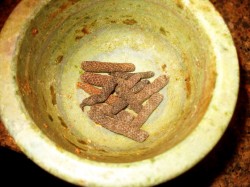
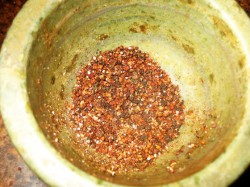
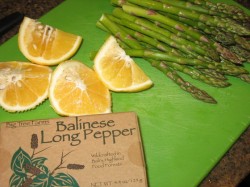
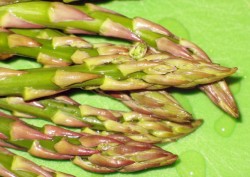
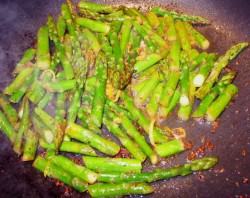


Oh cool! Yeah, been hitting up Salt Traders for over 3 years me thinks. Rob is an excellent person and loves his job. I believe he sold the Cooking School of Aspen to take up salt trading full time. I think I would have done the same.
Here’s what I did with the same corns:
http://www.cyberbilly.com/meathenge/archives/000843.html
They tough to get smooth and can get a little crunchy sparky. Mama wasn’t so keen, but I do love the peppery floral action of these little guys.
Biggles
Comment by Dr. Biggles — April 12, 2006 #
This is fascinating, Barbara. I always wondered what was used in Asia for spicy heat before the chili was introduced.
If it is still cultivated in India, I’m going to have to ask at our favourite Indian spice store to see if they sell this!
-Elizabeth
P.S. You’re right about Gernot Katzer. When I am looking for any sort of information on herbs and spices, he is invariably the one I turn to first on the internet. In fact, my Google search words are invariably the spice or herb name and “Katzer”….
Comment by ejm — April 13, 2006 #
Oooh, Doc–I -love- me some salmon. I want to be reincarnated as a big grizzly bear in my next life so I can gorge on blackberries and salmon for breakfast after a long winter’s sleep….
Elizabeth–it was long pepper and black pepper, primarily, though cinnamon and clove were considered warming or hot, too.
Chiles were very enthusiastically adopted when they arrived, but black pepper was still also prominent–though in Thailand, of course, they prefer white pepper. Which is the same thing as black pepper, just with the outer, black coat removed.
Comment by Barbara — April 14, 2006 #
Thank you for the commendation, but, I must admit, that I was introduced to longpepper by the erudite Herr Biggles.
I, did indeed, make a longpepper crust for my Valentine’s steaks. The lavender/floral/sweet spices bouquet enhances earthy beef. In fact, the s/o believes longpepper smells of that one olde tyme breath-freshener candy/gum that comes in the purple/silver wrapper. Um…in a good way.
I’m weird(perhaps) in that sometimes I just go thru my spice cabinet and sniff the bottles/baggies…maybe tasting a bit here and there…adding in a little salt as flavor conveyance. Longpepper is inviting in this respect.
…and gives your arms a workout as well grinding it up…
Congratualtions on curating such a worthwhile project. There can never be enough personal anecdotes of spice use and/or histories.
I hope to contribute in the future.
now…I believe some asparagus is calling my name…
Comment by Christopher Gordon — April 19, 2006 #
How wonderful that you got some. I love long pepper’s appearance. I also love the bright green of the spears 🙂
j
Comment by jasmine — April 19, 2006 #
Christopher–I would love it if you contributed!
I am not surprised that Biggles got you started on long pepper–he is very convincing….
Asparagus always calls my name….
Hey, jasmine! Long pepper is a handsome spice–I love all the colors, shapes and textures spices come in….
Comment by Barbara — April 19, 2006 #
Springy salad (with pictures)
Trackback by Patrick's Food Ramblings — April 20, 2006 #